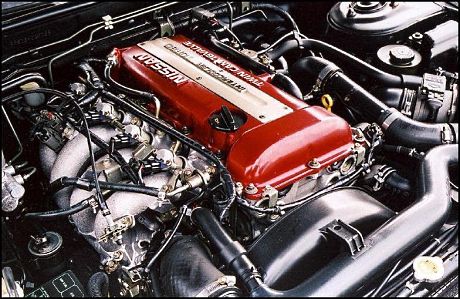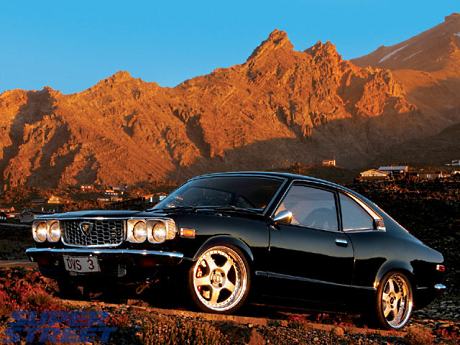Rare Bosozoku cars: Unknown car
People who read my personal blog already knew it, but I got married yesterday. I was hoping I would have a few minutes to post something for the rare bosozoku cars regular, but as it turned out to be I didn’t… So you have to be satisfied with some vip/bosozoku styled car which we could not identify…
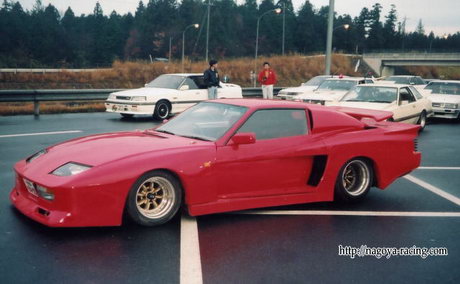
Unknown bosozoku styled car. Looks like a 80s Koenig Testarossa
It looks like it should resemble a Koenig Testarossa.
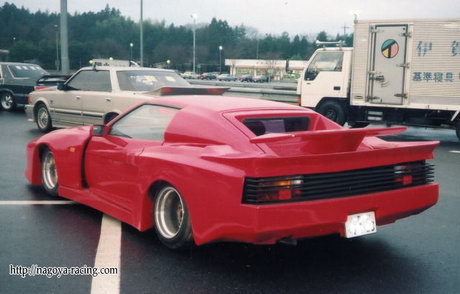
Unknown bosozoku styled car. Looks like a 80s Koenig Testarossa
Back in the late 80s and early 90s Koenig was one of the most immitated tuners in the bosozoku styling. Their wild widened bodies with extravaganza spoilers was exactly what the bosozoku car should look like!
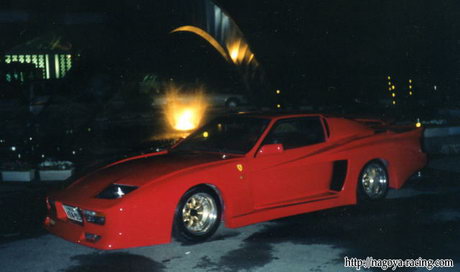
Unknown bosozoku styled car. Looks like a 80s Koenig Testarossa
What also helped was that gang bosses drove around in VIP cars (Mercedes, BMW, etc) which had been modified by tuners, like Koenig.
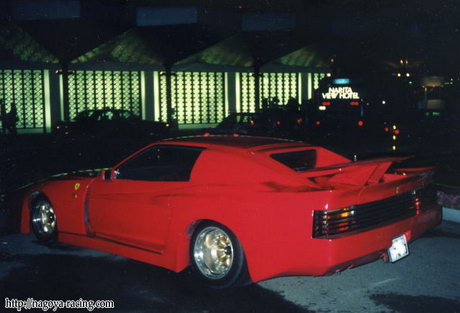
Unknown bosozoku styled car. Looks like a 80s Koenig Testarossa
The pictures were taken by Nagoya Racing and they look like they were taken during the early 90s…
Anyway, we were not able to identify the source for this car. Maybe you can help out?
by banpei with 2 commentsRare Bosozoku cars: Nissan S13 180SX
Last weekend we featured a very nicely exhaust of the week: a bosozoku styled Nissan 180SX!
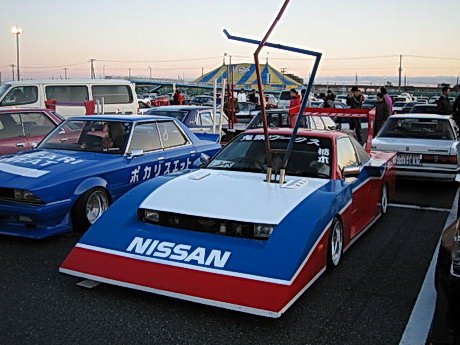
Exhausts look like a sculpture on this RPS13 180SX
The 180SX is a rare sight on the bosozoku meetings! We only found two examples of a 180SX and we even suspect that it is actually the same car!
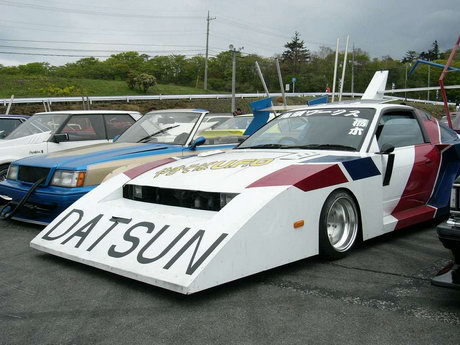
Bosozoku styled Nissan 180SX S13
Great mystery is why it is badged Datsun and not Nissan: the 180SX is too new to be badged Datsun abroad and in Japan Nissan never marketed as Datsun!
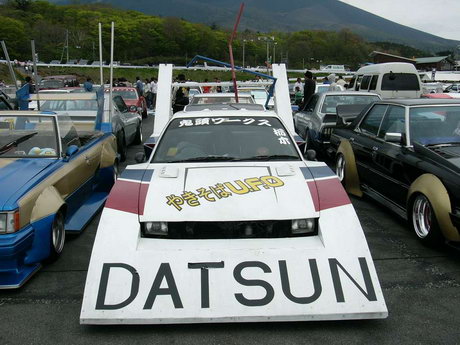
Bosozoku styled Nissan 180SX S13
The styling of this 180SX is a grancha version of the 180SX: you can’t even recognize it except by its roofline. It looks a bit more like a successor of the super silhouette formula Nissan Silvia Turbo S12!
When the Nissan S platform got into its fourth generation in March 1989 it created the Nissan 180SX (aka 200SX and 240SX abroad). The Nissan 180SX S13 was basically the successor in looks of the Nissan Silvia S12. The Nissan Silvia 180SX was a trim level of the Silvia S110 and the Silvia S12 was already well known in the US as the 200SX (without Silvia badging). It was quite naturally for Nissan to name the car with the SX badge when they decided to split up the Nissan S platform into two seperate models. This created the Nissan Silvia S13 and the Nissan 180SX S13.
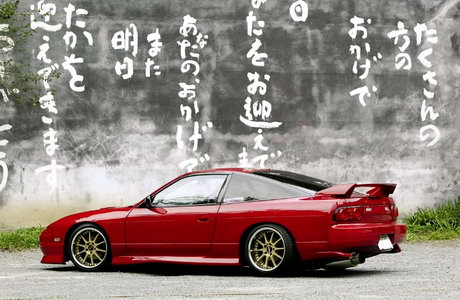
Factory stock kouki Nissan 180SX S13 Type X
In Japan the Silvia got a coupe bodytype with fixed headlights while the 180SX got a fastback (aka hatchback) bodytype with popup lights. It didn’t take long before the first combinations of those two started to appear in the streets: street racers who wrecked their 180SX frontends mated that with the lighter and cheaper Silvia frontend and created the Sileighty (aka Sil80) this way. The other way around wasn’t popular since it was heavier and required changes in the wiring. When Nissan spotted these conversions they decided to have an “official” Sileigthy as well. They had them produced by Kids Heart and sold some of those cars through the official Nissan dealer network. Also different combinations exist: S13.4 (S13 mated with Silvia S14 frontend) and S13.5 (S13 mated with Silvia S15 frontend, aka strawberry face) since the S platform remained the same.
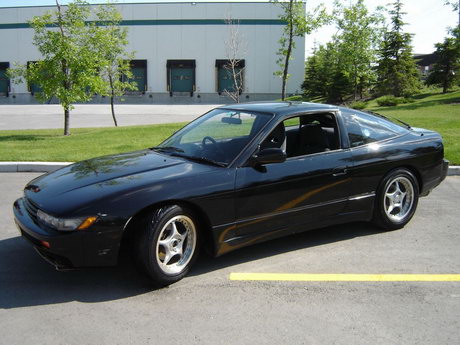
Nissan Silvia S13 and 180SX crossover: Sileighty
The 180SX initially got a 1.8 liter CA18DET, hence the 180SX designation, but in 1991 it got upgraded with the SR20DET engine and later on in 1996 with the SR20DE engine. It remained badged as the 180SX and not as the 200SX. Funny enough the 180SX was badged as the 200SX in Europe with the CA18DET engine and never got the SR20DET engine. In the US it was badged as the 240SX since it was powered by the KA24E and KA24DE engine: Nissan thought the US needed displacement instead of smaller turbo engines.
At first the 180SX was available as two versions: the Type I and Type II. The Type I was targeted for performance while the Type II was targeted for luxury. After the first facelift in 1991 the 180SX Type I got the SR20DET engine and got bigger brakes and a limited slip differential factory installed to handle the car better after this power increase. The Type II got the four wheel steering system HICAS II which got improved after the first facelift with the Super HICAS. After the second facelift in 1992 the Type III became available which was even more luxurious than the Type II: it got climate control and a cd player factory installed. After the third facelift in 1994 the Type I and Type II trim levels were renamed to Type R and Type X and the fourth facelift in 1995 only added a driverside airbag. The final facelift in 1996 had a lot of visual changes and added the cheaper Type S trim which offered the non turbocharged SR20DE and lacked the four wheel steering system. Production of the 180SX finally ceased in December 1998.
A great video of Ken Nomura (Nomuken) visiting the 180SX Type X assembly line in the Nissan factory somewhere late 90s:
The 180SX still remains very popular nowadays: it is a cheap mass produced rear wheel drive sportscar. Both its engine types have big potentials: both CA18DET and SR20DET can easily be tuned over 300HP and figures end somewhere between 500 and 700HP! Since the platform itself remained roughly the same almost all suspension upgrades for the newer S15 can be used on the S13 as well. Most people use the 180SX for drifting nowadays and it is often seen at MSC drift events!
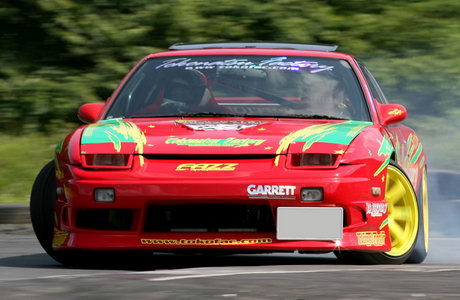
A Nissan 180SX driver participating in the MSC drift championship
In case you are wondering about the S13 designations you see at your average drift coverage: R stands for fastback/hatchback, P stands for SR20DE(T) and K for HICAS II/Super HICAS. That last designation will most probably be disabled on that car I guess… But of the time you will see either RPS13 (180SX with SR20), or RS13 (180SX with CA18), PS13 (Silvia with SR20) or plain S13 (Silvia).
I can imagine why the 180SX never got to be a popular bosozoku style car: it is too new to be popular in the 90s, it is too flashy and it is too modern styled. The examples above don’t leave much detail of the 180SX to be seen, so can we actually account them for a bosozoku styled 180SX?
by banpei with 1 commentRare Bosozoku cars: Mazda Savanna RX3
It is a bit weird: in contrary of the Mazda Cosmo AP RX5 the Mazda Savanna RX3 is a very rare Bosozoku styled car. We could only find two pictures of one single car!
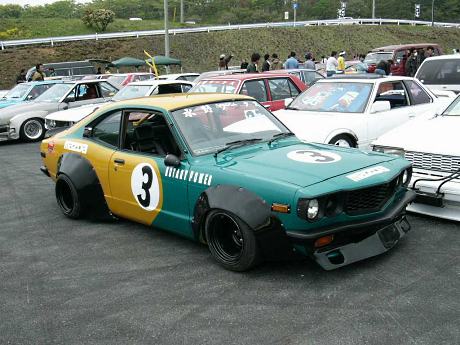
Bosozoku style Mazda Savanna RX3
Even though the Cosmo AP RX5 is a much bigger and meaner looking car, the Savanna RX3 is looking a lot meaner than its predecessor the Mazda Familia Rotary R100 and should really appeal all petrolheads.
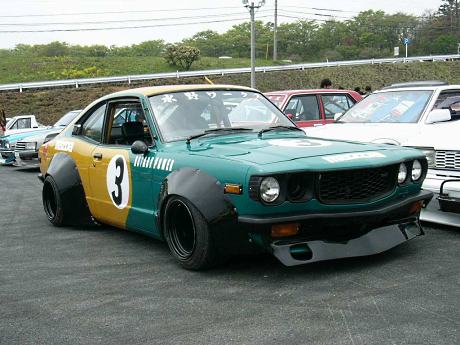
Bosozoku style Mazda Savanna RX3
The Mazda Savanna RX3 also had a big racing history: it debuted in 1971 at the Fuji 500 Tourist Trophy race and won instantly! It came just in time to prevent the Nissan Skyline GT-Rs from getting 50 consecutive wins for the Japanese Grand Prix!
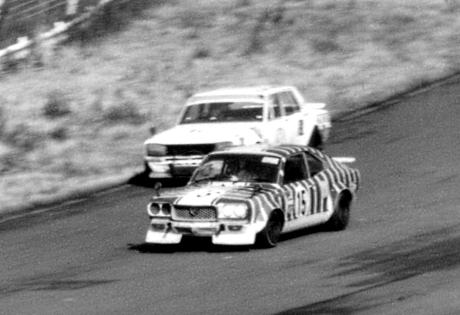
Winning Mazda Savanna RX3 on Fuji Speedway Tourist Trophy
If you are interested in this race, Japanese Nostalgic Car blog wrote an excellent article about this race!
The RX3 then continued to race for many years afterwards and even got over 100 victories at the end of 1976. It even is still being used for many different races nowadays: amoung them dragraces as well:
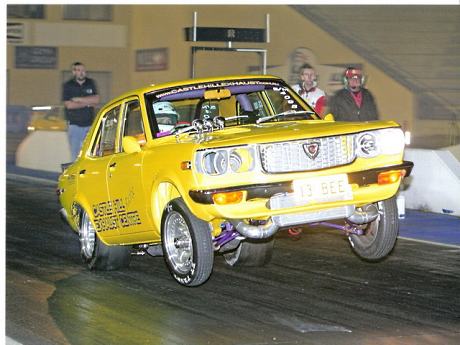
Mazda RX3 drag racer
The RX3 is based upon the Mazda Familia 808 platform (in some countries called 818), but then powered by a rotary engine instead of the inline 4 of the 808/818. The outside of the car remained the same except for the twin round headlights at the front and the round taillights at the back of the car.
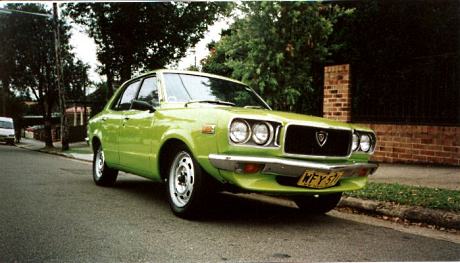
Factory stock Mazda Savanna RX3 4 door saloon
On the inside the interior was a bit more sportier than the standard Familia: the dash remained the same but it featured semi bucket seats.
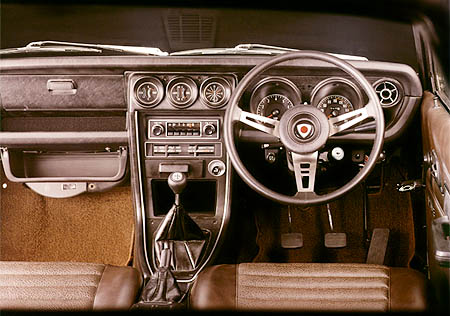
Mazda Savanna RX3 interior
What really helped was the weight of the car: the Familia only weights 865kg, so adding a powerfu
l rotary to such car makes it an instant winning combination! However the car still featured leaf springs and a live axle, so the handling of the car was not as good as the RX2 Capella. But what can you expect from a family car?
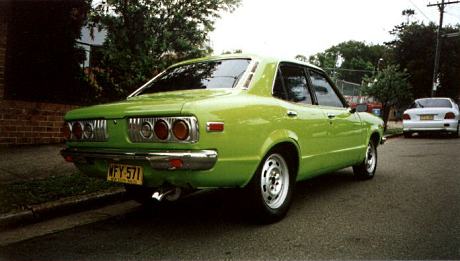
Factory stock Mazda Savanna RX3 4 door saloon
The Savanna was not only limited to the Coupe version of the Familia, but also delivered on the 4 door saloon and 5 door station van.
In Japan, Australia and Europe the Savanna was delivered with the 10A engine, while in the US only the 12A featured on the car. Starting from 1975 all it got an update and since then all Savanna RX3s got the 12A engine.
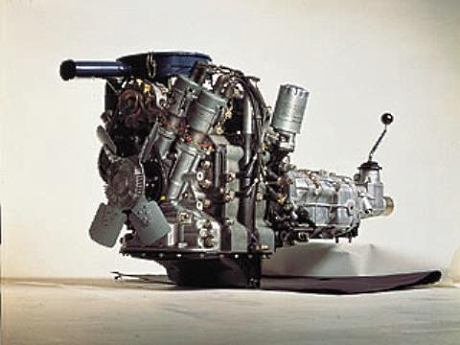
Mazda 10A Wankel engine
Of course the sporty image of the RX3 had to be mentioned over and over again. Take for example the poster for the RX3 SP:
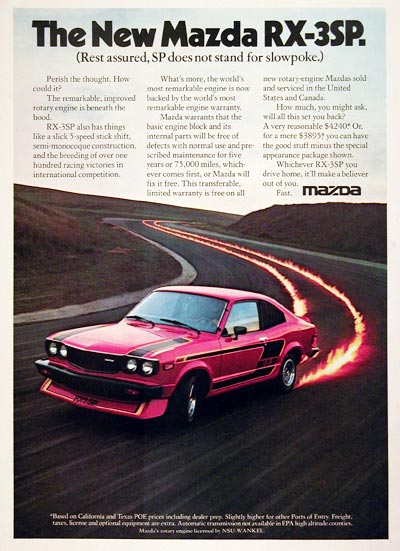
Mazda RX3 SP: not a slowpoke
All in all I don’t really understand why the Savanna RX3 is not a popular bosozoku style car: it looks bad, it had racing history (with wide fenders!), it features a rotary and best of all it was also available in 4 door saloons! A large package of elements which create a good foundation for a popular bosozoku car!
Maybe that is the whole point: it just reminded too much of the Familia family car. Or maybe it became an instant classic and the price remained too high during the 80s and 90s? Or maybe it was just the wrong car: the car that killed the 50th consecutive victory of the Skyline? Or maybe it was too small: the car is the size of a Nissan Sunny or Toyota Corolla. Who knows?
by banpei with 4 commentsRare Bosozoku cars: Mitsubishi Galant Lambda
This week we feature another rare Bosozoku styled car. This time I did find two Bosozoku styled examples of this car in contrary of the singular examples I previously posted.
This time we feature two Mitsubishi Galant Lambdas in different styles:
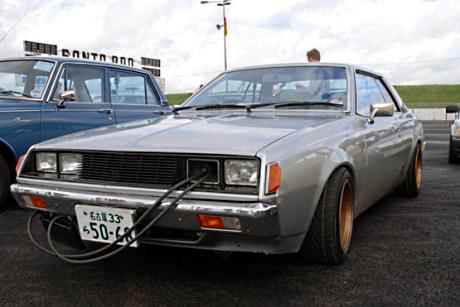
Mild Bosozoku styled Mitsubishi Galant Lambda
This Galant Lambda is a bit of a Kyusha styled car. Very nicely slammed to the ground with some phat rims and a nice oil cooler sticking under the bumper.
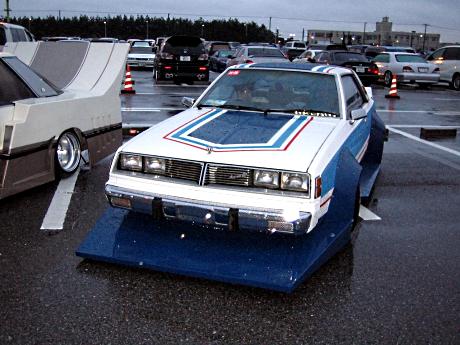
Wild Bosozoku styled Mitsubishi Galant Lambda
This wildly bosozoku styled Galant Lambda has it all: big overhanging lip at the front, big fenders, spoiler on the boot, 70s paint scheme, chromed mirrors and bumper, a hood ornament and let’s not forget the Astron 80 badge on the grille!
The Mitsubishi Galant Lambda was also known as the Mitsubishi Sapporo in the EU, Dodge Challenger and Plymouth Sapporo in the US, Chrysler Scorpion and the Mitsubishi Scorpion in Australia and the car was also known as the Colt Sapporo in the UK. That’s a lot of names!
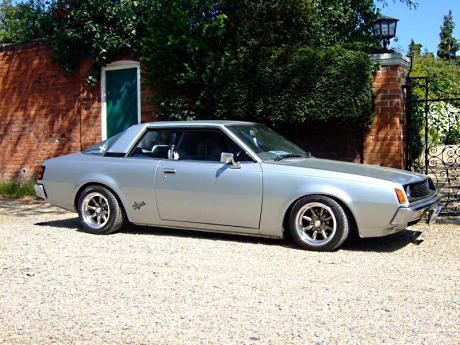
Almost factory stock zenki (1976-1980) Galant Lambda
The Galant Lambda was marketed as a “personal luxury car” which meant it was not considered a coupe. It was supposed to be a two door luxury vehicle based on a car from the larger model lineup. Most likely to match the “hardtop” designation by Toyota for the Crown and Chaser which were immediate competitors.
The car had a facelift in 1980 which resulted in a new grille with fixed lights, B pilar going into the roof lining instead of being a seperate beam, new rear lights and a set of spoilers to get it into the 80s era.
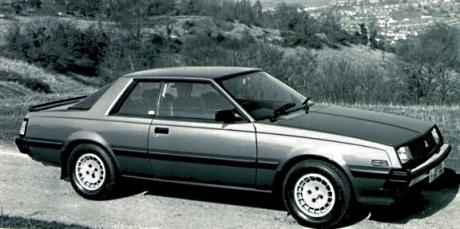
Factory stock kouki (1980-1982) Galant Lambda
The Galant Lambda featured several engines but the 4 cylinder Astron 80 was the most favorable engine of them all: it featured the “silent shaft” system. The “silent shaft” system was an improved version of a single balance shaft which counter balanced the vibrations made by the inline piston engine design. This system was the first use of twin balance shafts which enabled Mitsubishi to improve stability in the Astron engine and enlarge the engine over 2 liters. The Galant Lambda Astron 80 featured a 2.6 liter engine, a figure which was in the 70s normally only obtainable by adding at least two extra cylinders!
The Galant Lambda featured a futuristic design both outside and inside. It features a single spoke steering wheel and a wild spaceage interior. This interiour looked just as good as the interior of a Citroen SM back in 1976!
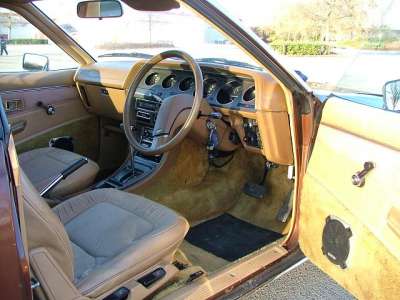
Factory stock interior Galant Lambda
On one side I understand why the Galant Lambda is a rare Bosozoku car: it is already a very wild styled car, on the other hand I don’t understand it: it reads potential all over it.
Perhaps it has to do with the brand Mitsubishi: Mitsubishi focused primarily on smaller cars during the 60s and early 70s while Nissan and Toyota already sold the larger saloons. Resulting in Mitsubishi’s being the 5th largest car manufacturer in Japan. Also Mitsubishi focused on Rally and not on circuit racing so they missed the Granchan followers.
As an ex-Mitsubishi owner I always wanted to buy a good condition Sapporo, however an AE86 came in between. Who knows, maybe I’ll own one myself one day. One thing is for sure then: it won’t be Bosozoku styled! 😉
by banpei with 3 commentsRare Bosozoku cars: Toyota Corona RT132
This week we don’t feature a popular bosozoku car, but a rare bosozoku car! We thought that featuring popular bosozoku cars each week would get a bit boring after a while so we want to alternate between popular and rare from now on. 😉
This week we have a rare bosozoku styled Toyota Corona RT132:
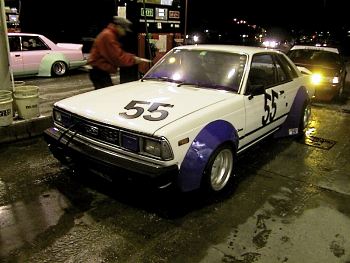
Rare Bosozoku styled Corona RT132 coupe
Big fender flares, deep dish wheels and an oil cooler on this baby! Would the number 55 refer to an old Formula Silhouette racer?
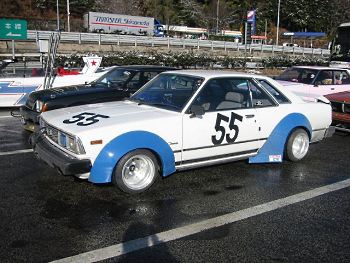
Rare Bosozoku styled Corona RT132 coupe
You may ask yourself how do I know it is a RT132? Quite simple: this Corona features the DOHC logo in the grille. The only engine with DOHC the Corona was delivered with is the 18R, so it can only be the RT132. Unless the owner rebadged the grille of course!
This car is the facelifted coupe version, which in my opinion is the best looking Corona T130.
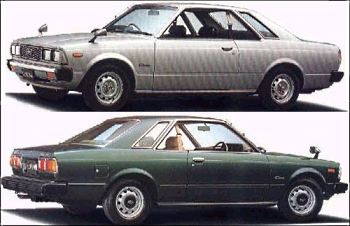
Factory stock photos of the Toyota Corona coupe
The Corona T120/T130 was the successor of the Corona T100/T110. The T120/T130 got a new floorpan and got an increased 25mm in wheelbase. The bizarre thing is that the successor of the T120/T130, the T140, decreased 25mm in wheelbase!
The Corona was placed against the Honda Accord, Mazda Capella, Nissan Bluebird and Toyota’s own Carina/Camry. The Corona itself was, compared to the Carina and Camry, the more upmarket car offering much more luxury and options than the Camry and Carina.
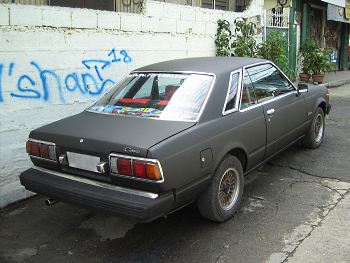
Almost factory stock Toyota Corona RT132 coupe
The Corona T130 got a large variety in engines and gearboxes, but the main engines in Japan were the 12T-U, 13T-U, 3T-U, 18R-GEU and the 21R-U.
I did see a TT132 (3T-U) for sale some time ago and thought about getting that car instead of my own, but personally I do like the styling of my Carina a bit better. However the Bosozoku styled example is more tempting than that 4 door Corona TT132 I saw back then…
by banpei with no comments yet